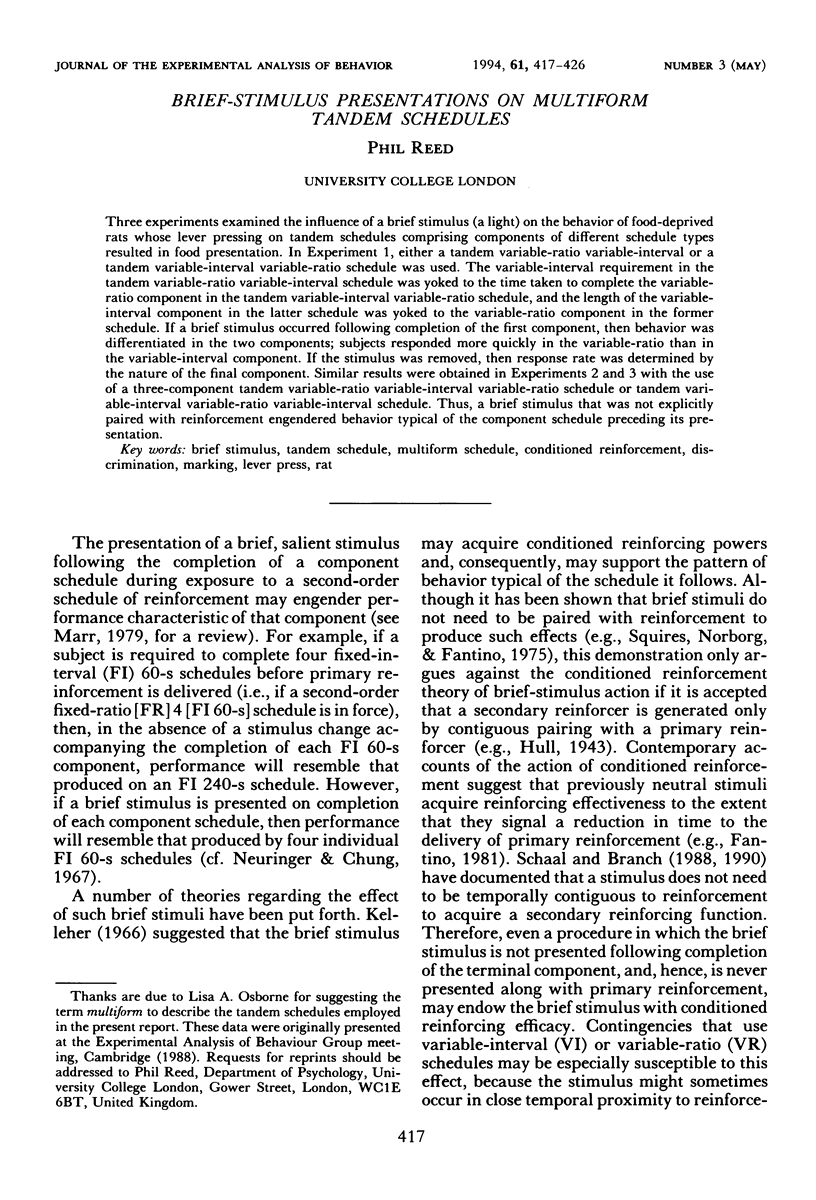Abstract
Three experiments examined the influence of a brief stimulus (a light) on the behavior of food-deprived rats whose lever pressing on tandem schedules comprising components of different schedule types resulted in food presentation. In Experiment 1, either a tandem variable-ratio variable-interval or a tandem variable-interval variable-ratio schedule was used. The variable-interval requirement in the tandem variable-ratio variable-interval schedule was yoked to the time taken to complete the variable-ratio component in the tandem variable-interval variable-ratio schedule, and the length of the variable-interval component in the latter schedule was yoked to the variable-ratio component in the former schedule. If a brief stimulus occurred following completion of the first component, then behavior was differentiated in the two components; subjects responded more quickly in the variable-ratio than in the variable-interval component. If the stimulus was removed, then response rate was determined by the nature of the final component. Similar results were obtained in Experiments 2 and 3 with the use of a three-component tandem variable-ratio variable-interval variable-ratio schedule or tandem variable-interval variable-ratio variable-interval schedule. Thus, a brief stimulus that was not explicitly paired with reinforcement engendered behavior typical of the component schedule preceding its presentation.
Keywords: brief stimulus, tandem schedule, multiform schedule, conditioned reinforcement, discrimination, marking, lever press, rat
Full text
PDF









Selected References
These references are in PubMed. This may not be the complete list of references from this article.
- Kelleher R. T. Conditioned reinforcement in second-order schedules. J Exp Anal Behav. 1966 Sep;9(5):475–485. doi: 10.1901/jeab.1966.9-475. [DOI] [PMC free article] [PubMed] [Google Scholar]
- Neuringer A. J., Chung S. H. Quasi-reinforcement: control of responding by a percentage-reinforcement schedule. J Exp Anal Behav. 1967 Jan;10(1):45–54. doi: 10.1901/jeab.1967.10-45. [DOI] [PMC free article] [PubMed] [Google Scholar]
- Schaal D. W., Branch M. N. Responding of pigeons under variable-interval schedules of signaled-delayed reinforcement: effects of delay-signal duration. J Exp Anal Behav. 1990 Jan;53(1):103–121. doi: 10.1901/jeab.1990.53-103. [DOI] [PMC free article] [PubMed] [Google Scholar]
- Schaal D. W., Branch M. N. Responding of pigeons under variable-interval schedules of unsignaled, briefly signaled, and completely signaled delays to reinforcement. J Exp Anal Behav. 1988 Jul;50(1):33–54. doi: 10.1901/jeab.1988.50-33. [DOI] [PMC free article] [PubMed] [Google Scholar]
- Squires N., Norborg J., Fantino E. Second-order schedules: discrimination of components. J Exp Anal Behav. 1975 Sep;24(2):157–171. doi: 10.1901/jeab.1975.24-157. [DOI] [PMC free article] [PubMed] [Google Scholar]
- Williams B. A., Royalty P. Conditioned reinforcement versus time to reinforcement in chain schedules. J Exp Anal Behav. 1990 May;53(3):381–393. doi: 10.1901/jeab.1990.53-381. [DOI] [PMC free article] [PubMed] [Google Scholar]
- Zuriff G. E. A comparison of variable-ratio and variable-interval schedules of reinforcement. J Exp Anal Behav. 1970 May;13(3):369–374. doi: 10.1901/jeab.1970.13-369. [DOI] [PMC free article] [PubMed] [Google Scholar]


